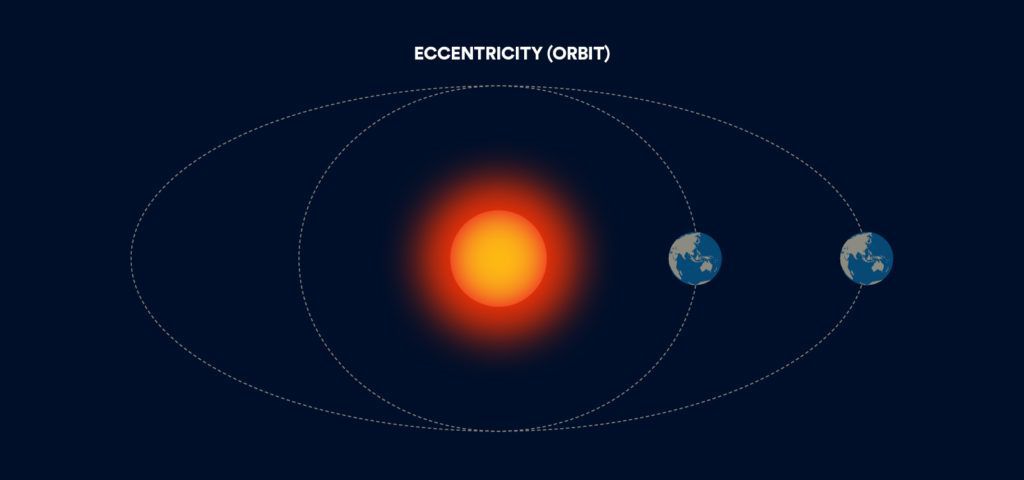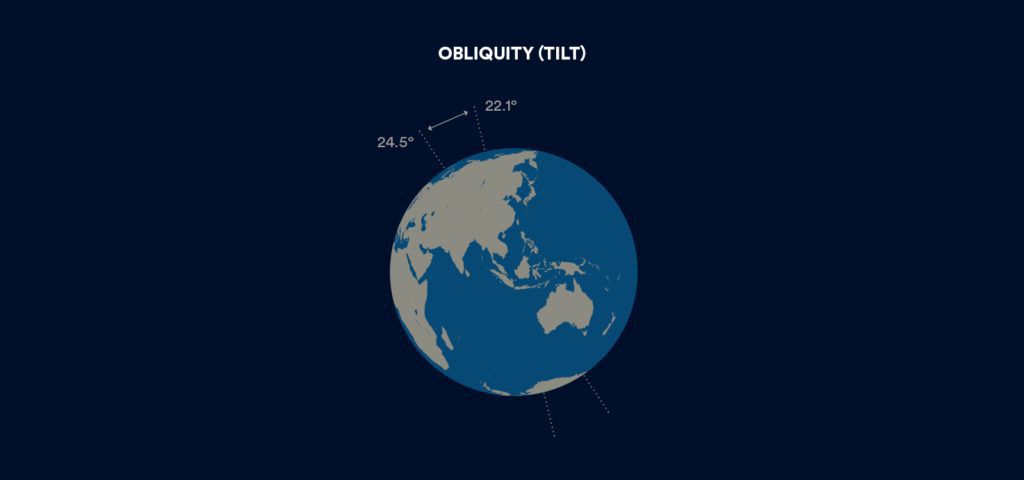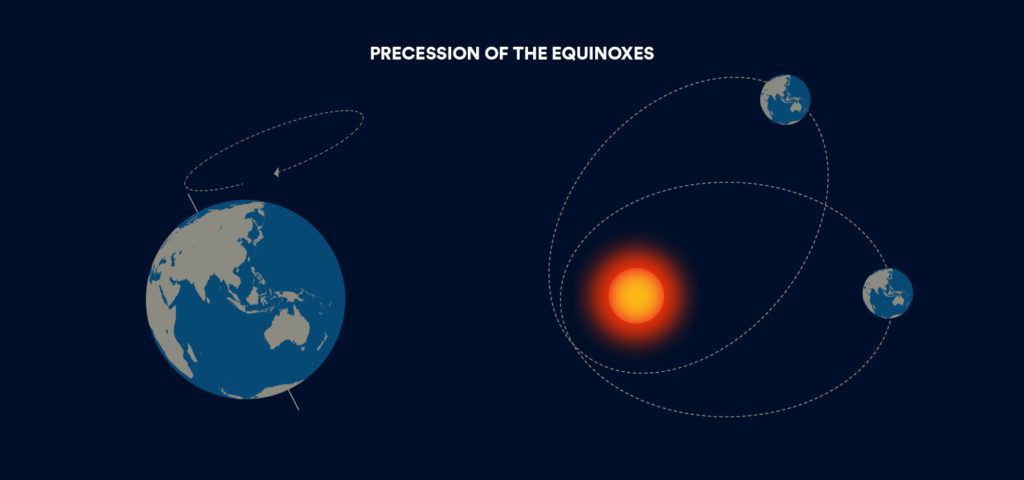Guest post by Astronomy Ambassador Karlie Noon.
Despite the plethora of data supporting human-driven climate change, too many of our world leaders and thought provokers continue to dismiss or misuse science for alternative agendas. All too often buzzwords like astronomical drivers/causes of climate change are misused and poorly explained, leading to confusion and distracting from the work that needs to be done to limit harmful global warming of over 1.5⁰C.
According to the natural climate cycle, Earth is currently coming out of a warm period and should be experiencing a cooling trend to transition into another ice age. For the past 40 years, NASA satellites have detected a reduction in the amount of solar radiation reaching Earth, suggesting we should be experiencing a gradual cooling, not rapid warming (Buis and NASA Jet Propulsion Laboratory, 2020). However, while there is evidence that this cooling trend was in motion, since the Industrial Revolution in the 1750s the Earth’s atmosphere has changed, with carbon dioxide levels increasing, not decreasing (Buis and NASA Jet Propulsion Laboratory, 2020).
Earth is experiencing remarkable global warming due to rising levels of carbon dioxide and greenhouse gases in the atmosphere. The smoking gun of our warming planet over the past 150 years is from anthropogenic causes, including fossil-fuel burning, agricultural processes, and other human factors contributing to a 47% increase in our atmosphere’s carbon dioxide levels (Buis and NASA Jet Propulsion Laboratory, 2019).
Let’s take a deep dive into the astronomical causes of Earth’s long-term climate cycles to see how the science is misrepresented.
Milankovitch cycles
Astronomical influences on Earth can have dramatic effects on its climate. Variations in Earth’s orbital features are some of the main drivers for ice ages in the past.
In the early 1900s, Serbian geophysicist and astronomer Milutin Milankovitch’s documented variations in the Earth’s rotation over extensive periods (Milankovitch, 1941) advancing our understanding of the planet’s orbit. Using calculations made previously by Joseph Adhémar (Adhémar, 1842), Milankovitch concluded that subtle variations in the planet’s orbit over thousands of years could indeed produce noticeable fluctuations in Earth’s temperatures.
In particular, Milankovitch determined that slight variations in Earth’s orbit, tilt, and precession of orbit were the main astronomical contributors to variations in Earth’s climate (Imbrie and Imbrie, 1980). Slight variations in any of these orbital features over thousands of years would eventuate in more or less solar radiation reaching Earth, impacting temperatures down here on the surface. These three cycles were dubbed the Milankovitch cycles.
Eccentricity (orbit)
Earth’s eccentricity describes variations in the elliptical Earth as it orbits the Sun. This cycle is around 100,000 years long, over which Earth’s orbit fluctuates from being very elliptical to an almost perfect circle (see Figure 1).
The Earth’s eccentricity can significantly affect the weather here on the surface. For example, when the Earth’s orbit is at its most elliptical, the planet experiences reduced sunlight over many thousands of years, resulting in a significantly cooler Earth. This is particularly important for the Northern, icy regions of the planet as a series of cold summers delay ice from melting, causing layers to build up resulting in an ice age every 100,000 years or so (Muller and McDonald, 1997).

Figure 1: Two examples of Earth’s orbit around the Sun. The inner orbit exhibits low eccentricity (almost circular) with the outer orbit exhibiting high eccentricity (elliptical).
Obliquity (tilt)
Obliquity or tilt describes how the planet tilts with respect to the plane in which the Solar System is positioned. The higher the obliquity (axial tilt), the more the Northern Hemisphere is exposed to the sun’s rays (insolation). Conversely, the lower the obliquity, the less solar radiation reaches the Northern Hemisphere, resulting in more mild summers and winters worldwide. Interestingly, these cycles can overlap, creating even more variations in temperatures experienced on Earth. For example, if obliquity is low and eccentricity is large, an ice age is likely to occur.

Figure 2: Earth’s axis tilt varying between 24.5 degrees and 22.1 degrees.
Precession of the Equinoxes (wobble)
The final cycle, the precession of the Equinoxes, is concerned with the wobble of Earth’s axis as it rotates. This cycle has a period of 26,000 years and comes in two forms: the wobble induced by tidal forces from the Sun, Moon and Jupiter; and an elliptical wobble, leading to variations in the position of the orbit’s aphelion (the furthest place from the Sun) and perihelion (the closest to the Sun).

Figure 3: Two variations of precession cycles. Left: precession of Earth’s rotational axis. Right: precession of Earth’s orbit.
Earth’s wobble causes variations in the seasons, creating cooler or warmer summers depending on what hemisphere is at perihelion, with warmer summers for the hemisphere tilted toward the Sun. According to NASA, Earth is currently coming out of a warm period and should be experiencing a cooling trend to transition into another ice age
Natural cycles
Data derived from tree rings, ice cores, corals and sediments have allowed scientists to reconstruct the past 800,000 years of Earth’s weather, giving rise to a prominent cycle called the natural cycle (Petit, 1999). Using this data, climate scientists have identified a well-known, predictable pattern in Earth’s climate. This cycle is primarily constrained by the above-mentioned Milankovitch cycles, all combining to create either icy or warm periods (Berger, 1988).
The natural cycle gives evidence for the Earth’s warming and cooling as a part of its processes. This fluctuation in warming and cooling generally occurs over 100,000 years, with approximately 80–90,000 years in an ice age and 10–20,000 years in a warm period (Sergin, 1979).
Anthropogenic climate forcing
While Milankovitch cycles generate climate changes over thousands of years, our recent warming event has rapidly increased temperatures in just 150 years. It is clear from the available data that our current rapid rise in temperatures is unprecedented.
Climate forcing occurs when the climate is affected by physical factors outside the climate system, such as volcanoes erupting or an increase in greenhouse gases. The difference between natural and human-caused climate forcing is apparent when considering Earth’s climate trends over the past 800,000 years. While astronomical influences do cause significant variations in the Earth’s climate, these cycles are well understood and are not accounting for the current warming the planet is experiencing. The dramatic deviation from the natural cycle correlates with anthropogenic activity, undeniably indicating global warming is human-made.
Some may claim that astronomical drivers explain our current warming, don’t be fooled by the fools. They may know some of this fascinating science but only the amount necessary to push their unfounded agendas.
Bibliography
A. Adhémar, Révolutions de la Mer: Déluges Périodiques, Carilian-Goeury et V. Dalmont, Paris, 1842
Berger, Milankovitch theory and climate, Rev. Geophys., 26(4), pp 624–657, 1988
Buis and NASA Jet Propulsion Laboratory, ‘The Atmosphere: Getting a Handle on Carbon Dioxide’, 2019 https://climate.nasa.gov/news/2915/the-atmosphere-getting-a-handle-on-carbon-dioxide/ First accessed 20 November 2020
Buis and NASA Jet Propulsion Laboratory, ‘Why Milankovitch (Orbital) Cycles Can’t Explain Earth’s Current Warming’,
https://climate.nasa.gov/blog/2949/why-milankovitch-orbital-cycles-cant-explain-earths-current-warming/ First accessed 20 November 2020
Hansen and M. Sato, ‘Paleoclimate Implications for Human-Made Climate Change’, NASA Goddard Institute for Space Studies and Columbia University Earth Institute, New York, 2011
Imbrie and J. Z. Imbrie, Modelling the climatic response to orbital variations, Science, 207, 1980, pp 943–953
Milankovitch, Kanon der Erdbestrahlung und seine Andwendung auf das Eiszeiten – problem, R. Serbian Acad., Belgrade, 1941
A. Muller and G. R. MacDonald, ‘Spectrum of 100-kr glacial cycle: Orbital inclination, not eccentricity’, Proc. Natl. Acad. Sci. USA, 94, 1997, pp 8329–8334
J.R. Petit et al., ‘Climate and atmospheric history of the past 420,000 years from the Vostok ice core, Antarctica’, Nature, 399, 1999, 429–436.
Roe, ‘In defense of Milankovitch’, Geophys. Res. Lett., 33, 2006, L24703, doi:10.1029/2006GL027817.
Rogan, J. (2020), Joe Rogan Experience #1555 – Alex Jones & Tim Dillon. https://www.youtube.com/watch?v=jdVso9FSkmE&ab_channel=PowerfulJRE
Y. Sergin, ‘Numerical modeling of the glaciers‐ocean‐atmosphere system’, J. Geophys. Res., 84, 1979, pp 3191–3204



Current warming is not “unprecedented”. The end of the Younger Dryas occurred when Earth’s atmospheric temperature increased 6 to 10 degrees C in a matter of only a decade. This catastrophic warming is probably the basis of the ancient “Great Flood” stories.
At some time in my past education, I learned that one degree on our earth was equal to approximately 70 miles. If this is true, then each one degree of earth’s tilt would mean that the sun’s rays would reach 70 miles farther north. This would account for some of the warming of our polar areas; however, as has been written in the above, it does not account for the current state of earth’s warming.
Each of us provides for a small amount of carbon print, and as a result, the more people we have on our earth the greater the amount of green house gases will occur. In our country, USA, our population has doubled over the past 70 years. This along with the tilt of our earth may well explain why earth’s increase in warming is occuring. While there is nothing we can do about earth’s tilt, we can look at our population increases. Of course as China (PRC) found out, this is something that was not popular and in the end had to be rejected. All that is left is to continue with our attempt to control our green house gasses. How can this be accomplished, our scientists need to begin looking into how these green house gasses and be reconverted to a useful form. Surely, this is a possibility since nothing can leave our earth other than by brute force, this must be addressed rather than accepting there is nothing that can be done. Our natural resources are being consumed, but there is little need to worry about this concern at the present time. We cannot predict what our earth will be like in another few hundreds of years; therefore, our worries for the future are of no consequence to us. The future generations will need to find out how to live with their problems, and they will, just as we had to. Surely, no one would believe that mankind of hundreds of years ago could have predicted how we live today, and we cannot predict our future generations.
Thank you for this explanation, I was aware of this wobble, but not of the science that has been applied to this study comparing all of these variances .
“Some may claim that astronomical drivers explain our current warming, don’t be fooled by the fools. They may know some of this fascinating science but only the amount necessary to push their unfounded agendas”
This was myself included . I have never found an explanation like this before. Thank you again
I am concerned that The wobbling on the earth Is noticeably changing. Around 2000 and13The sun started rising on the north east side of my house and setting on this southwest side of my house I’m sorry north west side of my house. Before that there was never any sun on the north side of my house. I live in Delaware and since 2013 it is been very noticeable that the sun Is walking Further Towards the north On both sunrise and sunset Interestingly it is very noticeable I used to rise and set directly in front of my front door and backdoor but now it rises and sets Way across the street from where I live and it’s still seems to be moving further to the north on sunrise and sunsets. I have never seen it walk that far cross street So to me it is very noticeable that the wobble on the earth is increasing At an alarming rate. I’ve told people about this and I have measured it And the increase and the walk of the sun I would say the angle increase from the front door to where it’s rising now It’s probably 7 or 8%. And this change has happened In the last 7 or 8 years. I would like to know where scientist really stand On this large increasing a wobble of your over such a short duration of time. Thank you.